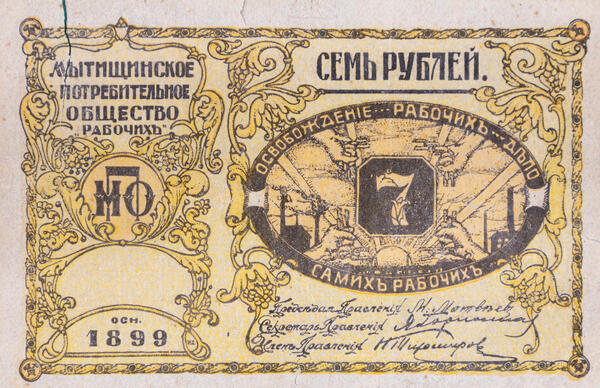The history of the cooperative movement in Russia is over a century-long. Mytishchi was one of the first cities where consumer cooperation became popular. A consumers' cooperative is a voluntary union. The initial property of a consumers' cooperative is composed of contributions of its members.
The cooperative movement grew rapidly in Russia in the late 19th century. The goals of the Cooperative are defined in the first paragraph of their 1898 Charter: ‘The Mytishchi Consumer’s Cooperative of Workers is established in Mytishchi with the goal of providing its members with consumer and household goods at the lowest price possible or at a moderate price and give its members an opportunity to make savings with the profit from this business activity’.
By 1917, the Mytishchi Consumers' Cooperative was one of the largest in Russia. Its assets tallied 577,000 rubles with an annual turnover of 2,994,000 rubles. By the 1930s, the Consumers' Cooperative covered 18.2% of all population of the Mytishchi District, mostly villagers. The number of members reached 3,031. During the Great Patriotic War, the Consumers' Cooperative of Mytishchi maintained their potential and did a lot to provide the locals with food.
The front of the banknote features text and the phrase “The Mytishchi Consumers' Cooperative of Workers. MCC. Seven rubles. Freeing workers is the workers' own job. Chairman of the Board. Secretary of the Board. Member of the Board. Established in 1899. Seven rubles.” The back of the note reads: “This banknote is in circulation only in the stores of the Mytishchi Consumers' Cooperative of Workers. The Mytishchi Consumers' Cooperative shall not be held liable to compensation in case of loss of this banknote.” The banknote features a popular type of graphic abbreviation: the letters МПО (MCC) stand for the MYTISHCHI Consumers' Cooperative in Russian. Chafing marks and tears on the banknote are indicative of its heavy use.
The cooperative movement grew rapidly in Russia in the late 19th century. The goals of the Cooperative are defined in the first paragraph of their 1898 Charter: ‘The Mytishchi Consumer’s Cooperative of Workers is established in Mytishchi with the goal of providing its members with consumer and household goods at the lowest price possible or at a moderate price and give its members an opportunity to make savings with the profit from this business activity’.
By 1917, the Mytishchi Consumers' Cooperative was one of the largest in Russia. Its assets tallied 577,000 rubles with an annual turnover of 2,994,000 rubles. By the 1930s, the Consumers' Cooperative covered 18.2% of all population of the Mytishchi District, mostly villagers. The number of members reached 3,031. During the Great Patriotic War, the Consumers' Cooperative of Mytishchi maintained their potential and did a lot to provide the locals with food.
The front of the banknote features text and the phrase “The Mytishchi Consumers' Cooperative of Workers. MCC. Seven rubles. Freeing workers is the workers' own job. Chairman of the Board. Secretary of the Board. Member of the Board. Established in 1899. Seven rubles.” The back of the note reads: “This banknote is in circulation only in the stores of the Mytishchi Consumers' Cooperative of Workers. The Mytishchi Consumers' Cooperative shall not be held liable to compensation in case of loss of this banknote.” The banknote features a popular type of graphic abbreviation: the letters МПО (MCC) stand for the MYTISHCHI Consumers' Cooperative in Russian. Chafing marks and tears on the banknote are indicative of its heavy use.



